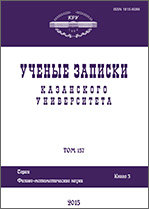|
|
Uchenye Zapiski Kazanskogo Universiteta. Seriya Fiziko-Matematicheskie Nauki, 2018, Volume 160, Book 2, Pages 410–418
(Mi uzku1467)
|
 |
|
|
$d$-Posterior approach in regression
A. A. Zaikin
Kazan Federal University, Kazan, 420008 Russia
Abstract:
In this paper, we have used the $d$-posterior approach in
regression. Regression predictions are a sequence of similarly made
decisions. Thus, $d$-risk can be helpful to estimate the quality of
such decisions. We have introduced a method to apply the
$d$-posterior approach in regression models. This method is based on
posterior predictive distribution of the dependent variable with the
given novel input of predictors. In order to make $d$-risk of the
prediction rule meaningful, we have also considered adding
probability distribution of the novel input to the model.
The method has been applied to simple regression models. Firstly,
linear regression with Gaussian white noise has been considered. For
the quadratic loss function, estimates with uniformly minimal
$d$-risks have been constructed. It appears that the parameter
estimate in this model is equal to the Bayesian estimate, but the
prediction rule is slightly different. Secondly, regression for the
binary dependent variable has been investigated. In this case, the
$d$-posterior approach is used for the logit regression model. As
for the $0$–$1$ loss function, the estimate with uniformly minimal
$d$-risk does not exist, we suggested a classification rule, which
minimizes the maximum of two $d$-risks. The resulting decision rules
for both models are compared to the usual Bayesian decisions and the
decisions based on the maximum likelihood principle.
Keywords:
Bayesian inference, regression, $d$-risk.
Received: 12.10.2017
Citation:
A. A. Zaikin, “$d$-Posterior approach in regression”, Uchenye Zapiski Kazanskogo Universiteta. Seriya Fiziko-Matematicheskie Nauki, 160, no. 2, Kazan University, Kazan, 2018, 410–418
Linking options:
https://www.mathnet.ru/eng/uzku1467 https://www.mathnet.ru/eng/uzku/v160/i2/p410
|

|




 Contact us:
Contact us: Terms of Use
Terms of Use
 Registration to the website
Registration to the website Logotypes
Logotypes







 Citation in format
Citation in format 